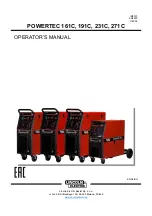
- 44 -
4
LOAD APPLICATION DURING FAULT TRACING
Applying a useful load to the unit during fault tracing depends on the type of fault and the possi-
bilities.
List of loads:
•
No load
•
Short circuit
•
Ohmic load resistance
•
Water resistor
•
Welding
At no load, test whether no-load voltage is applied and whether it is approx. 90 V. However, you
must select Electrode mode or start the unit by pressing the Torch button. Usually, you then 'hear'
a high frequency.
When the mode is changed from DC to AC, the polarity of the no-load voltage must reverse.
If a torch and a load resistor are unavailable, you can also operate systems of this series in short-
circuit mode. But remember that the inverter control board A8 has a monitoring circuit which de-
tects short circuits and then reduces the current to be approx. 80 A. You can disable this function
by connecting a jumper on the board.
If you have a suitable ammeter, you can test most unit functions when it is in the short-circuit con-
dition:
Examples:
•
Current control range and maximum currents
•
Current waveform in case of AC current (slightly biased)
•
Time pattern, starting current, changeover to second current (by second Torch button),
remote-regulator functions, ramp setting, etc.
A ballast resistor can be used to simulate a load similar to welding for a given current. This is only
practical for static loads. The dynamic response of the arc cannot be simulated by means of an
ohmic resistance. Compared to welding, differences are mainly obvious in the electrode and the
TIG AC current.
Select the resistance so that, for a given current, you obtain the point on the standard curve for
the desired welding process.
Standard curve for electrode welding: U = 20 V + 0.04
Ω
* I; R = U/I = 20 V/I + 0.04
Ω
Standard curve for TIG welding:
U = 10 V + 0.04
Ω
* I; R = U/I = 10 V/I + 0.04
Ω
In practice, use is commonly made of resistors ranging from 0.05
Ω
to 0.2
Ω
.
Water resistors permit infinitely variable adjustment of the resistor.
Fault tracing can also be conducted during welding operations as some faults only become ap-
parent during the welding process. For measurements, however, a comparatively high interfer-
ence level, e.g. resulting from HF pulses, must be taken into account. Measuring cables may be
connected to induce defects on electronic control boards, since they function as aerials and feed
excessively high interference currents.
Содержание Aristotig 405 AC/DC
Страница 1: ...0458 165 002 9910 DTG 405 Aristotig 405 AC DC Welding rectifier Service manual...
Страница 9: ...9 NOTES...
Страница 10: ...10 CONNECTION DIAGRAM DTG 405...
Страница 11: ...11...
Страница 15: ...15 NOTES...
Страница 16: ...16 BLOCK DIAGRAM DTG 405 405a pcx...
Страница 17: ...17 Warning Some parts of this circuit are connected to mains voltage potential 405b pcx...
Страница 27: ...27 A2 COMPONENT POSITIONS a2 1b pcx a2 2b pcx...
Страница 30: ...30 A4 A11 COMPONENT POSITIONS Warning The circuit and its parts are connected to mains voltage potential...
Страница 40: ...40 A9 A13 COMPONENT POSITIONS A10 A14 COMPONENT POSITIONS...
Страница 57: ...57 209 201 212 203 204 205 206 207 208 D04 0301 1 214 215 216 218 217 219 220 110 221 222 213 202...
Страница 62: ...62 8 WAVEFORM AC2 SMOOTH WAVE ac2 pcx...
Страница 67: ...67 LOAD CHARACTERISTICS NOTES 0 10 20 30 40 50 60 70 80 90 0 50 100 150 200 250 300 350 400 A V TIG MMA DTG 405...
Страница 81: ...81 NOTES...
Страница 86: ...86 D04 0304 1 D04 0305 0 501 502 503 502 502 504 505 506 507 508 509 510 511 512 513 515 516 505 517...
Страница 91: ...page...
















































